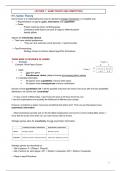Samenvatting
Managerial Economics (D0H52a) Samenvatting nieuwe prof 2024
- Instelling
- Katholieke Universiteit Leuven (KU Leuven)
Samenvatting van het vak Managerial Economics: Analytical Tools (D0H52a), gegeven in het 2e jaar bachelor Handelsingenieur (in de Beleidsinformatica) door Tommaso Alba. Slides en lessen samengevat, in ieder geval duidelijker dan de prof zijn slides! Deze samenvatting kan gebruikt worden ipv de s...
[Meer zien]




